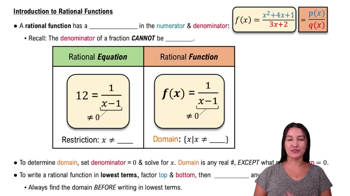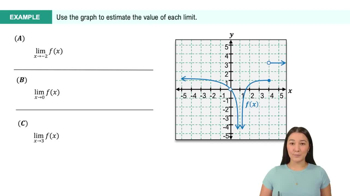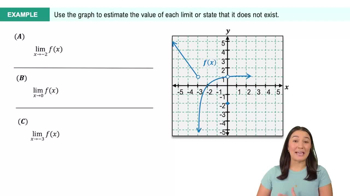Table of contents
- 0. Functions7h 52m
- Introduction to Functions16m
- Piecewise Functions10m
- Properties of Functions9m
- Common Functions1h 8m
- Transformations5m
- Combining Functions27m
- Exponent rules32m
- Exponential Functions28m
- Logarithmic Functions24m
- Properties of Logarithms34m
- Exponential & Logarithmic Equations35m
- Introduction to Trigonometric Functions38m
- Graphs of Trigonometric Functions44m
- Trigonometric Identities47m
- Inverse Trigonometric Functions48m
- 1. Limits and Continuity2h 2m
- 2. Intro to Derivatives1h 33m
- 3. Techniques of Differentiation3h 18m
- 4. Applications of Derivatives2h 38m
- 5. Graphical Applications of Derivatives6h 2m
- 6. Derivatives of Inverse, Exponential, & Logarithmic Functions2h 37m
- 7. Antiderivatives & Indefinite Integrals1h 26m
- 8. Definite Integrals4h 44m
- 9. Graphical Applications of Integrals2h 27m
- 10. Physics Applications of Integrals 2h 22m
1. Limits and Continuity
Introduction to Limits
Problem 2.47c
Textbook Question
Horizontal and Vertical Asymptotes
Use limits to determine the equations for all vertical asymptotes.
x² + x ― 6
c. y = ------------------
x² + 2x ― 8
 Verified step by step guidance
Verified step by step guidance1
Step 1: Identify the vertical asymptotes by setting the denominator equal to zero. Solve the equation \(x^2 + 2x - 8 = 0\) to find the values of \(x\) where the function is undefined.
Step 2: Factor the quadratic equation \(x^2 + 2x - 8\) to find its roots. This can be done by finding two numbers that multiply to -8 and add to 2.
Step 3: Once the roots are found, these values of \(x\) are the vertical asymptotes. Use limits to confirm that the function approaches infinity as \(x\) approaches these values from either side.
Step 4: To find horizontal asymptotes, compare the degrees of the numerator and the denominator. Since both are quadratic, divide the leading coefficients of \(x^2\) terms.
Step 5: Use limits to verify the horizontal asymptote by evaluating \(\lim_{x \to \infty} \frac{x^2 + x - 6}{x^2 + 2x - 8}\) and \(\lim_{x \to -\infty} \frac{x^2 + x - 6}{x^2 + 2x - 8}\).
 Verified video answer for a similar problem:
Verified video answer for a similar problem:This video solution was recommended by our tutors as helpful for the problem above
Video duration:
3mPlay a video:
Was this helpful?
Key Concepts
Here are the essential concepts you must grasp in order to answer the question correctly.
Vertical Asymptotes
Vertical asymptotes occur in a rational function when the denominator approaches zero while the numerator does not. This indicates that the function's value increases or decreases without bound as it approaches a specific x-value. To find vertical asymptotes, we set the denominator equal to zero and solve for x.
Recommended video:

Introduction to Cotangent Graph Example 1
Limits
Limits are a fundamental concept in calculus that describe the behavior of a function as it approaches a particular point. They are essential for analyzing the values of functions near points of discontinuity, such as vertical asymptotes. By evaluating limits, we can determine the function's behavior as it approaches the asymptote from either side.
Recommended video:

One-Sided Limits
Rational Functions
Rational functions are expressions formed by the ratio of two polynomials. They can exhibit unique behaviors, such as vertical and horizontal asymptotes, depending on the degrees of the numerator and denominator. Understanding the structure of rational functions is crucial for identifying asymptotes and analyzing their limits.
Recommended video:

Intro to Rational Functions

 6:47m
6:47mWatch next
Master Finding Limits Numerically and Graphically with a bite sized video explanation from Callie
Start learning




